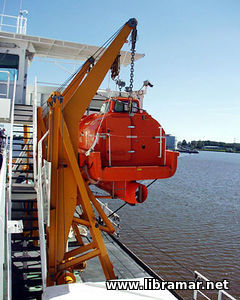
This article is continuing the one giving brief introduction to the immersion suits. Practice makes perfect. If in doubt, the manufacturer's instructions are printed on the bag or the labels attached to the suit. To put on, or don, the immersion suit, as an exercise first take your safety boots to avoid any damage. Take a suit out of the bag. Check its condition. Then, insert one foot first. In an emergency, boots can be left on to save time and keep heat in. it is also advisable to wear as much warm clothing as you can. The suit is designed for both these purposes. The regulations stipulate that the person should be able to enter into an immersion suit within two minutes. This will need practice. If there is another crew member nearby, it is a good idea to help each other as it will save time and energy.
Once the suit is on, the wearer must get rid of any excess air inside it. Place a couple of fingers inside the face seal and squeeze the suit to express the air. Remove fingers before standing upright, otherwise air will re-enter. If the legs and feet have air in them, it could affect the wearer's balance when in the water and this could result in drowning.
Most suits are not floatation approved so a life jacket will be required.
Over-mittens should be worn if the hands are not expected to operate machinery or assist with evacuation. Getting off a sinking ship into the sea is dramatic. The temptation to jump must be avoided as any remaining residual air within the suit could cause it to rupture as it rapidly becomes immersed. The wearer should either use disembarkation ladder or wait for the water to rise to such level that would allow to safely step off the vessel. Be aware of other people in the water and take note of any sharp objects that might tear the suit.

 temperature drops another couple of degrees, this muscular activity starts to fail. In northern latitudes, when the waters are colder, this can happen in just fifteen minutes to an unprotected person. By that time you will lose muscular control and start to lose the ability to think patiently - this could be irreversible and result in death. This situation need not arise if you know how an immersion suit works and are able to get into it correctly. It is very clever piece of kit that needs to be looked after. The suit is a one-piece item that is stored in a bag for easy access.
temperature drops another couple of degrees, this muscular activity starts to fail. In northern latitudes, when the waters are colder, this can happen in just fifteen minutes to an unprotected person. By that time you will lose muscular control and start to lose the ability to think patiently - this could be irreversible and result in death. This situation need not arise if you know how an immersion suit works and are able to get into it correctly. It is very clever piece of kit that needs to be looked after. The suit is a one-piece item that is stored in a bag for easy access.

